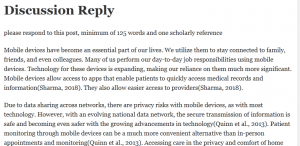Discussion Reply

please respond to this post, minimum of 125 words and one scholarly reference
Mobile devices have become an essential part of our lives. We utilize them to stay connected to family, friends, and even colleagues. Many of us perform our day-to-day job responsibilities using mobile devices. Technology for these devices is expanding, making our reliance on them much more significant. Mobile devices allow access to apps that enable patients to quickly access medical records and information(Sharma, 2018). They also allow easier access to providers(Sharma, 2018).
Due to data sharing across networks, there are privacy risks with mobile devices, as with most technology. However, with an evolving national data network, the secure transmission of information is safe and becoming even safer with the growing advancements in technology(Quinn et al., 2013). Patient monitoring through mobile devices can be a much more convenient alternative than in-person appointments and monitoring(Quinn et al., 2013). Accessing care in the privacy and comfort of home benefits individuals with barriers to receiving in-person care.
Some examples of individuals who benefit from using mobile devices in public health are those who live in rural areas and those who lack access to transportation. Other individuals who may benefit from this are those with language barriers, those who can’t afford to miss work to attend appointments, or fear seeking help due to the stigma associated with their condition, such as mental illness or addiction. When people have easier access to care, they are more likely to receive the care they need to maintain health and life, which improves public health.